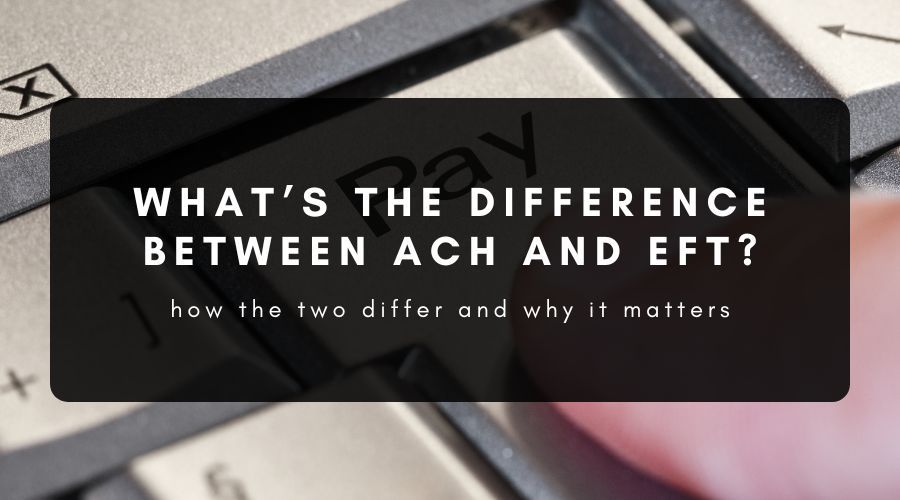What’s the Difference Between ACH and EFT?

ACH and EFT are two terms that are often used in the payments industry, but a lack of definitions can make it hard to distinguish between the two. The main difference between ACT and EFT is that ACH describes electronic funds transfers that are processed through the Automated Clearing House Network in the United States, while EFT describes any kind of electronic payment made around the world.
EFT and ACH Payments: The Difference Explained
Talking about the difference between ACH and EFT makes them sound like two items that belong to an overarching category, in the same way that apples and oranges both belong to the category of fruits. However, in this case, EFT is the category (fruit) and ACH is the item (apple, orange etc.) along with other items like wire transfers and debit card transactions.
It’s important to note that “EFT payments” is often used when talking about ACH equivalents outside of the United States, such as SEPA in Europe. But perhaps a more precise term would be “electronic bank transfers”—as these transfers are completed without an intermediary, in contrast to card payments that involve a card network and a payment processor that’s linked to a merchant account.
What Is an Electronic Funds Transfer?
An electronic funds transfer occurs anytime that money is transferred from one bank account using electricity rather than by withdrawing and depositing cash or a cheque. The following are all types of EFT payments or electronic payments:
- Transferring money from your savings account to your everyday account using an ATM, online or phone banking
- Online bill pay
- ACH payments (in the United States)
- SEPA payments (in Europe)
- eCheques
- Wire transfers
- Peer-to-peer payments using a service like PayPal or Stripe
- Purchases with credit and debit cards through a point-of-sale terminal or payment gateway
ACH Payments Explained
ACH transfers can be made between bank accounts held by participating financial institutions in the United States, including banks and credit unions. After being initiated by the sender or receiver, the requests are sent in batches to the Automated Clearing House for routing and payment into the appropriate bank account.
The two kinds of ACH transactions are direct deposit and direct payment:
- Direct deposits are sent from companies or the government to other companies or individuals. They include things like payroll, government benefits, tax refunds, annuities and retirement payments.
- Direct payments are sent from individuals to companies, the government or other individuals. They are used for paying bills, paying taxes or sending money to family or friends.
Depending on the direction it goes, an ACH payment may be labelled as an “ACH debit” or “ACH credit” on the customer’s bank statement. The transfer is marked as a debit on the bank account from which the funds came and as a credit on the bank account that received the funds.
Electronic Payment Methods Compared
Many people who are asking about the difference between ACH vs EFT payments are interested in knowing how electronic payment methods compare in terms of security, speed and cost—or perhaps which options are available in their area.
For example, an employer might be deciding whether to pay employees, contractors and freelancers with a paper pay cheque or via an ACH direct deposit. Likewise, an e-commerce merchant needs to know whether to add electronic transfers to a bank account as a payment method or simply focus on credit and debit cards.
Security
When it comes to security, electronic bank transfers (including ACH payments) are the most secure. These kinds of EFT transactions are generally covered by national and international laws and don’t carry the same risks of fraud and credit card chargebacks as transactions made using credit and debit cards. In the United States, ACH payments are covered by the Electronic Funds Transfer Act (1978), which protects customers in the case of a bank error.
Speed
In terms of speed, debit and credit cards, e-wallet payments and mobile payments are the fastest—often being approved in seconds and settled in one or two business days. In contrast, ACH payments can take several days to arrive in the recipient’s bank account, although same-day transfers are becoming more common. Wire transfers usually arrive on the same day or at most on the next business day. This is because they are processed individually rather than in batches.
Cost
ACH transfers (and their equivalents around the world) are usually the most cost-effective kinds of electronic payment. Depending on the sending and receiving banks, they are usually free or carry a minimal fee. Wire transfers are the most expensive, costing around €40-50 for the sender and around €10 for the receiver. Card payments cost more than ACH payments but far less than wire transfers with average processing fees of around 3%.
Additional Features
Electronic payments made through a payment gateway with credit cards, debit cards and e-wallets come with the advantages of centralised sales data tracking and merchant services like real-time transaction information, recurring billing and dedicated customer service. Some merchant services providers also offer multi-currency processing, which is an advantage for international businesses that would otherwise lose funds on currency exchange.
Which EFT Payment Method Should I Use?
For remote transfers, the best electronic payment method depends on the security and speed that you need, the options offered by your financial institution and how much it makes sense to spend on the transaction.
Generally, ACH transfers are best for one-off or repeating domestic payments in the United States, credit card payments through a payment gateway are best for buying and selling products online and wire transfers are best for sending money to family abroad.
